Key takeaways:
- Metal sculpting combines creativity and craftsmanship, offering a journey of self-expression and resilience through challenges.
- Essential tools like angle grinders, welding machines, and safety gear significantly enhance precision and enjoyment in the sculpting process.
- Understanding metal types and properties, such as steel’s strength and aluminum’s lightness, is crucial for choosing the right material for artistic effects.
- Techniques like MIG welding, brazing, and soldering are pivotal for joining metals, each providing unique challenges and lessons in creativity.
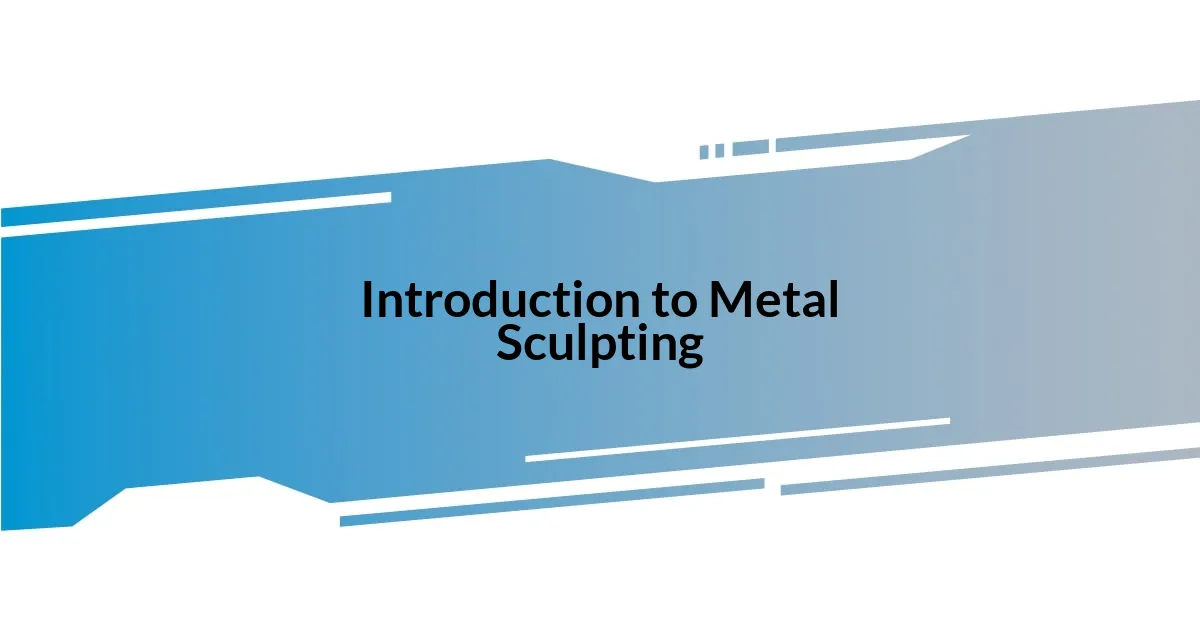
Introduction to Metal Sculpting
Metal sculpting is where creativity meets craftsmanship, transforming raw materials into stunning works of art. I remember my first encounter with metal; it was both intimidating and exhilarating. The weight of the materials felt overwhelming, yet there was something incredibly freeing about bending and shaping metal to my will.
As I delved deeper into the craft, I discovered that metal sculpting isn’t just about the physical act of shaping—it’s also a journey of self-expression. Have you ever felt that rush of adrenaline while chiseling away at a piece, watching it slowly evolve into something that reflects your inner vision? Each piece tells a story, often intertwined with my emotions and experiences, revealing a part of me that words sometimes can’t capture.
My journey through metal sculpting has taught me patience and resilience. There were times when a piece didn’t come together as I imagined, leaving me frustrated. Yet, as I learned to embrace those challenges, I found new techniques and inspirations that pushed my artistry further than I ever expected. Each failure turned into a stepping stone, reminding me that the beauty of metal sculpting is in the process as much as in the final creation.
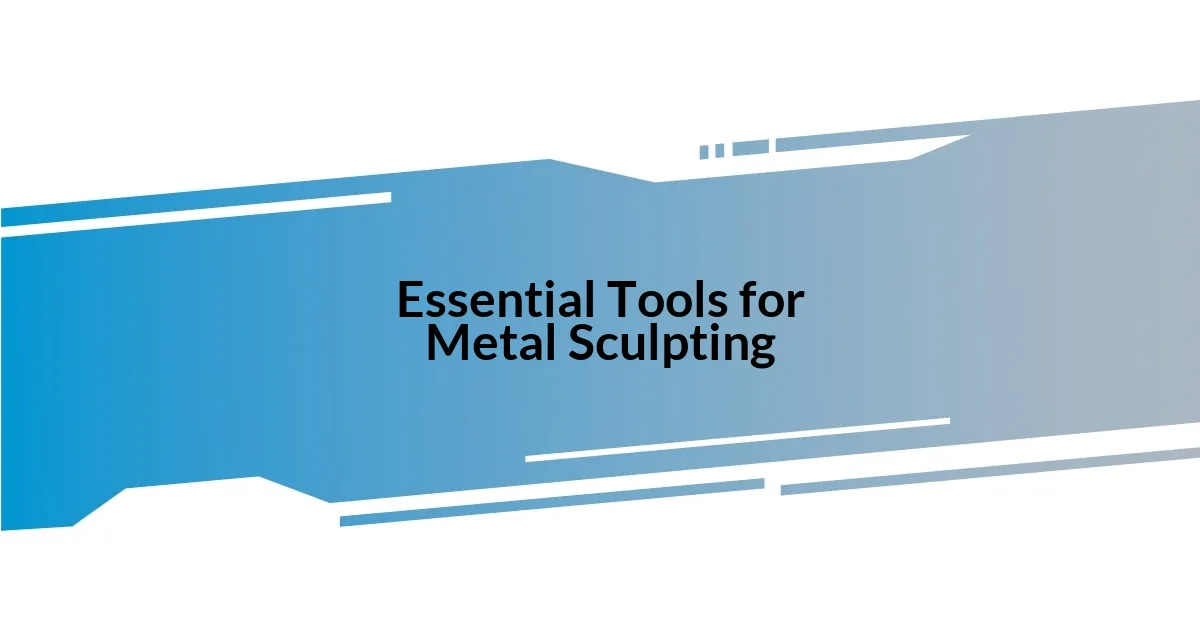
Essential Tools for Metal Sculpting
When I first started metal sculpting, I quickly realized that having the right tools was crucial to unleashing my creativity. It’s fascinating how the right implement can drastically enhance both precision and enjoyment in my work. From basic hand tools to electric gadgets, each tool plays a unique role in transforming my ideas into reality.
Here’s a rundown of essential tools that I recommend for anyone getting into metal sculpting:
- Angle Grinder: This powerhouse tool allows for cutting and shaping metal with ease, vital for those initial stages of sculpting.
- Welding Machine: Whether you’re working with MIG, TIG, or stick welding, a solid machine is necessary for creating sturdy joints and adding intricate details to your sculptures.
- Plasma Cutter: I still remember the first time I used a plasma cutter—it felt like magic! This tool enables precise cutting of metal with minimal effort.
- Bending Tools: Having a good set of bending tools can really open up creative possibilities in metalwork, allowing for beautiful curves and shapes.
- Safety Gear: Never underestimate the importance of keeping yourself safe. A reliable pair of gloves, goggles, and a welding helmet should always accompany your equipment.
Investing in these essential tools has not only improved my workmanship but also made the entire process more enjoyable. I’ve learned that the right tool can turn a frustrating task into a seamless flow of creativity, sparking inspiration in ways I never expected.
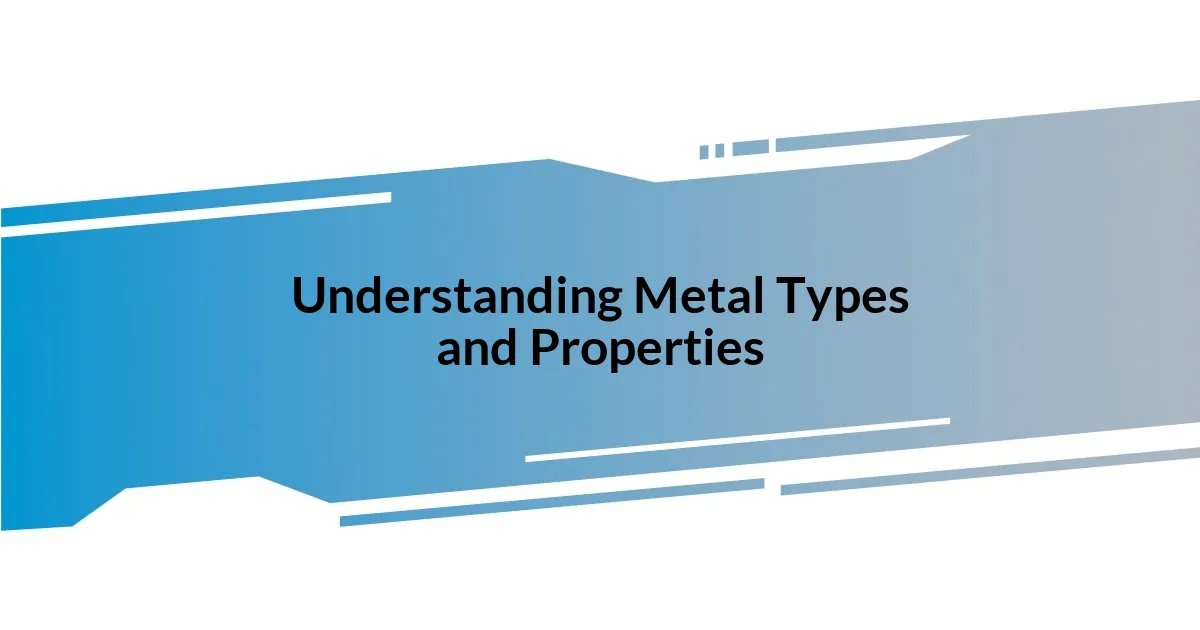
Understanding Metal Types and Properties
Understanding different types of metal and their properties is fundamental to metal sculpting. Each metal brings its own character and possibilities to your work. For instance, I’ve always been drawn to steel for its strength and versatility. When I created my first large installation, I chose steel because it could withstand the elements while allowing me to experiment with design.
Aluminum, on the other hand, is remarkably lightweight and easy to work with, making it perfect for intricate pieces. I remember crafting a series of hanging sculptures from aluminum; the way they danced in the breeze was magical. It taught me the importance of choosing the right material for the right effect—the difference between an imposing presence and a delicate whisper in my art.
Understanding properties like malleability and tensile strength also shapes how I approach each project. For example, copper’s malleability opens up opportunities for detailed designs that can be bent and shaped beautifully. I’ve often found myself lost in the process of hammering out the unique textures that copper can marry with light, creating pieces that seem to communicate their story through the patterns in their surface.
| Metal Type | Properties | Best Uses |
|---|---|---|
| Steel | Strong, durable, versatile | Outdoor sculptures, large installations |
| Aluminum | Lightweight, corrosion-resistant | Intricate pieces, hanging sculptures |
| Copper | Malleable, excellent for detailing | Textured designs, jewelry |
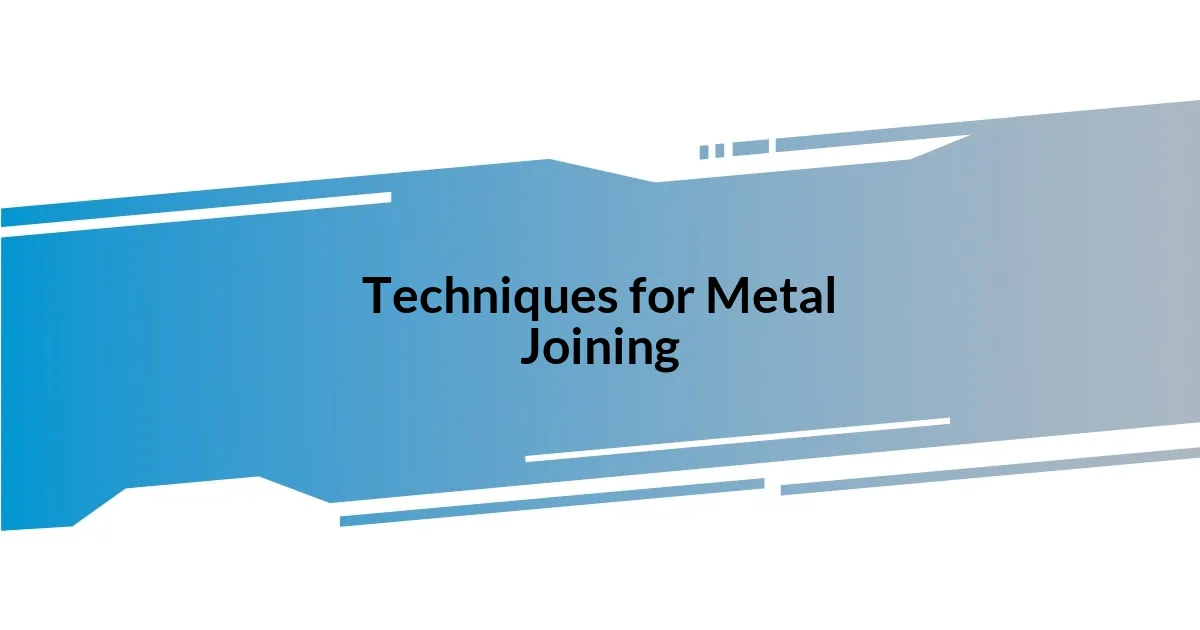
Techniques for Metal Joining
When it comes to metal joining, several techniques can make a world of difference in your sculpting journey. Personally, I’ve found MIG welding to be my go-to technique. It’s quick, relatively easy to learn, and allows for lots of versatility. I still recall the first time I joined two metal pieces together—watching that satisfying spark and realizing I could create a solid bond was a pivotal moment for me. Isn’t it incredible how a few sparks can fuse ideas into reality?
Another technique I often lean on is brazing, especially when working with dissimilar metals. Unlike welding, brazing requires lower temperatures, which can preserve the integrity of parts that might warp under heat. I remember constructing a mixed-media piece where I needed to join copper and steel. The challenge of ensuring they bonded beautifully, without compromising either material, turned out to be a rewarding experience. Have you ever faced such a challenge, where the technique itself led you to a creative breakthrough?
Finally, I can’t overlook soldering, particularly for smaller or intricate works. It was with soldering that I first experimented on a delicate piece, a miniature sculpture that required a subtle touch. I recall feeling like a conductor orchestrating a symphony of tiny metal pieces. The precision required in soldering taught me patience—something vital in sculpture. Isn’t it fascinating how each technique can teach us not just about joining metal, but also about ourselves and our artistic process?
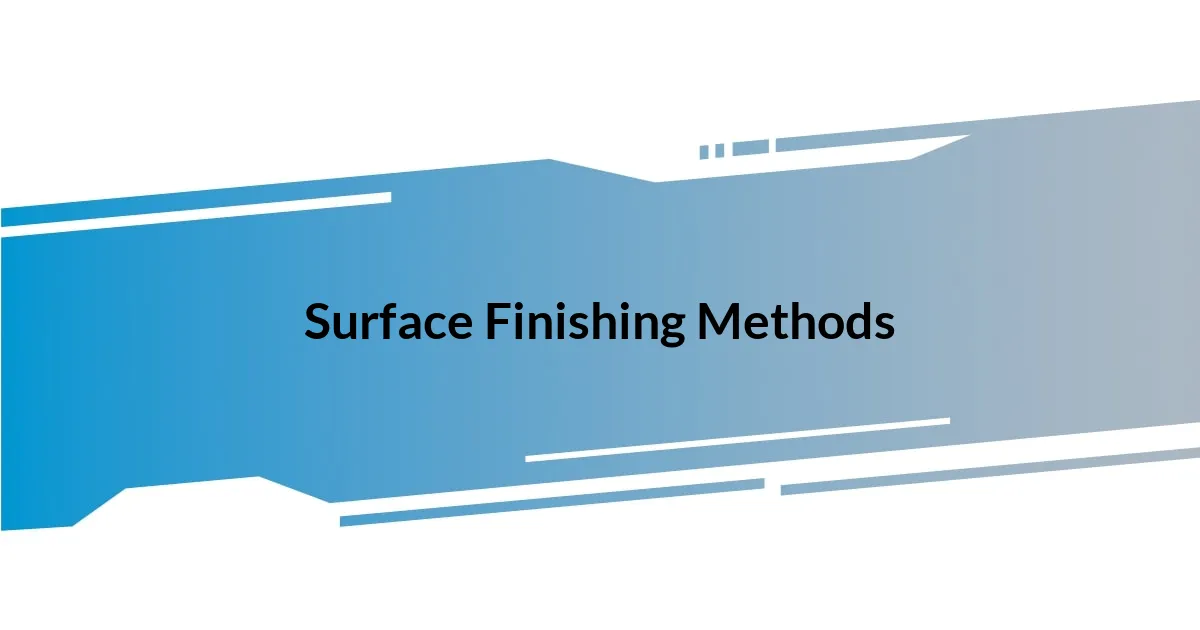
Surface Finishing Methods
Surface finishing methods can transform a metal sculpture from a raw form into a polished piece of art, showcasing the artist’s vision and technique. My favorite method is sandblasting, which gives an intriguing texture while preparing a surface for further treatment. I remember one piece where the contrast between the roughness created by sandblasting and the smooth finish I applied later evoked a sense of duality, as if the sculpture was simultaneously raw and refined. Have you ever experienced the thrill of revealing the character hidden beneath a metal surface?
Another finishing technique I enjoy is patination, which adds color and depth to a piece. I fondly recall experimenting with vinegar and heat to achieve a vibrant green patina on a copper sculpture. Watching those colors come to life altered the entire mood of the artwork, evoking emotions I didn’t anticipate. Isn’t it fascinating how a single chemical reaction can spark an entirely new dimension in your work?
Lastly, I often employ polishing for a sleek, reflective finish that draws viewers in. I remember spending hours polishing a stainless steel sculpture; the process became meditative. Each stroke brought out a brilliance that mirrored not just the surroundings but also the essence of the piece I was creating. Isn’t it incredible how the right finishing technique can elevate your work, inviting viewers to explore the interplay between light and form?
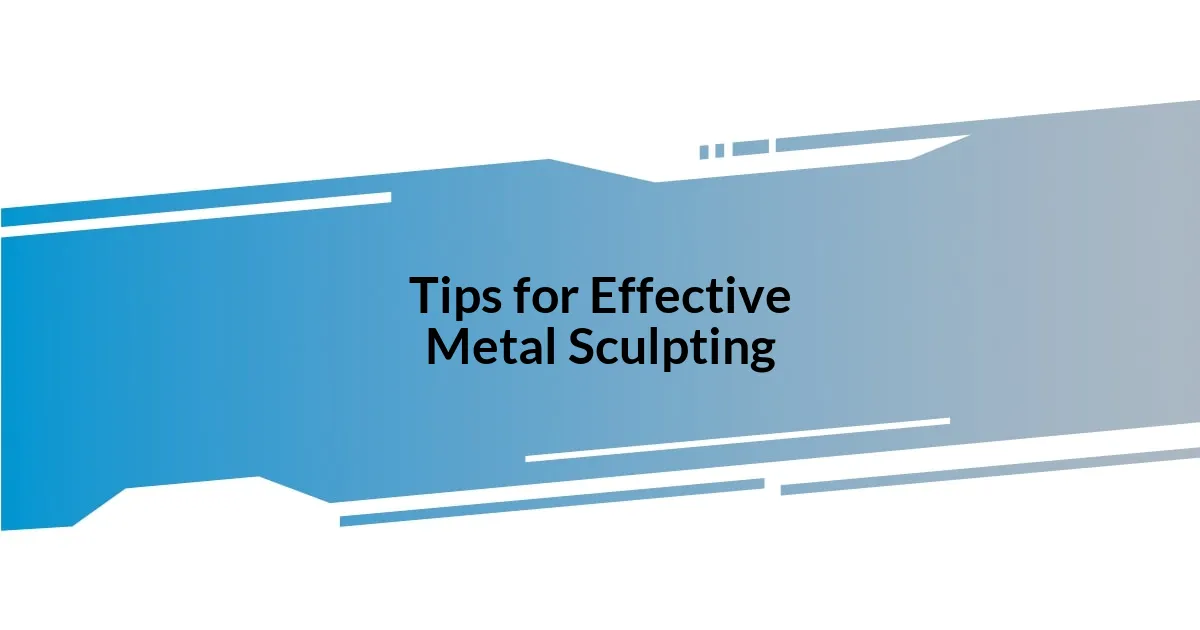
Tips for Effective Metal Sculpting
When it comes to effective metal sculpting, planning your design on paper before diving into materials can save you a lot of time and frustration. I remember feeling overwhelmed during my early days when I tried to sculpt straight from my imagination. It was as if I were trying to navigate a forest without a map! Taking the time to sketch out my ideas not only clarified my vision but also let me visualize how each component would fit together. Have you ever felt lost in your own creative process?
Another crucial tip is to embrace experimentation. I’ve often found that the most exciting breakthroughs come when I step outside my comfort zone. One time, I decided to mix different metals I’d never combined before, like brass and aluminum. The results were unexpected—I created a dynamic contrast that energized the piece and taught me that taking risks can lead to rewarding outcomes. Isn’t it thrilling to think how the fear of failure can sometimes be overshadowed by the excitement of discovery?
Finally, never underestimate the power of patience in metal sculpting. I once spent weeks perfecting a large installation, and there were days I felt like giving up. However, I learned that embracing the slow and meticulous process actually deepens my connection to the work. Every careful adjustment and repeated polishing made me appreciate not just the material but the journey itself. Can you recall a moment where patience paid off in your own creative adventures?